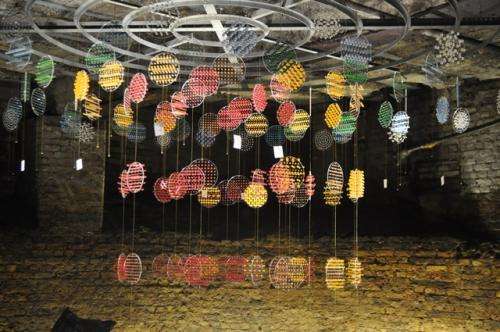Image of the installation mid-way through installation.
A subterranean physics-inspired art installation housed in a Victorian ice well beneath the London Canal Museum will open to the public on 24 August.
Commissioned by the Institute of Physics (IOP) as the first in a programme of artists-in-residence called Superposition, the installation is the outcome of an exciting partnership between physicist Ben Still and artist Lyndall Phelps.
The artwork, called 'Covariance', is made up of 1 km of brass rods, 28,000 glass beads, hundreds of acrylic discs and 36,000 diamantes. It is suspended in a circular brick space – about 30 feet in diameter – underneath the museum.
"As you descend the ladder, the environment changes – it's darker, cooler, sounds are different; you do feel like you're entering a true subterranean world," says Lyndall, on the artwork's location in the former ice well.
On seeing the final artwork, Ben, a particle physicist at Queen Mary, University London, said, "The installation sneaks up on you, you feel like you have discovered your own active particle detector. The surroundings, regular structure, and colour palette reflect the role of particle detectors and the data they record in the most visually grasping way."
Lyndall, an installation artist with an interest in science, was inspired by Ben's description of the work being undertaken at Super-Kamiokande, a detector and part of the T2K experiment in Japan.
"The closer I got to completing the installation the more excited I became; as each section of disks were added the spectacle intensified," said Lyndall on completing the artwork.
"The finished work is everything I had hoped for and more, it takes my breath away! The sheer beauty and magic of Covariance has made the months of intricate hand-made construction worthwhile."
Creating the hand-made work was a laborious task for the artist, reflecting the intense labour effort required to create a particle detector, along with the complex logistics involved in doing so.
The installation is also inspired by the way the data from the detectors is read by physicists – from the coloured dot diagrams that physicists like Ben use today to the female 'computers' employed yesteryear.
Lyndall adds, "Huge numbers of women (who were called computers) were employed to do this role. Many of my past works have dealt with the physical labour undertaken by women, especially the repetition of specific tasks. I was keen for the production of the work to encompass this work ethic and to use materials that reflected women's craft, hence the use of glass beads and diamantes."
As well as the artwork itself, the meetings between Ben and Lyndall form an important part of the IOP's project. Their discussions and thoughts have been captured on a blog to expose the artistic processes and their interplay with the science.
You can read the blog at www.physics.org/superposition.
Caitlin Watson, Head of Public Engagement at IOP, said, "I'm thrilled with what Lyndall and Ben have created from their conversations over the past nine months. Lyndall's artwork is truly awesome and captures the elegance and allure of physics in a way that will inspire visitors to have their own conversations about physics. "
More information: www.physics.org/superposition/
Provided by Institute of Physics





















